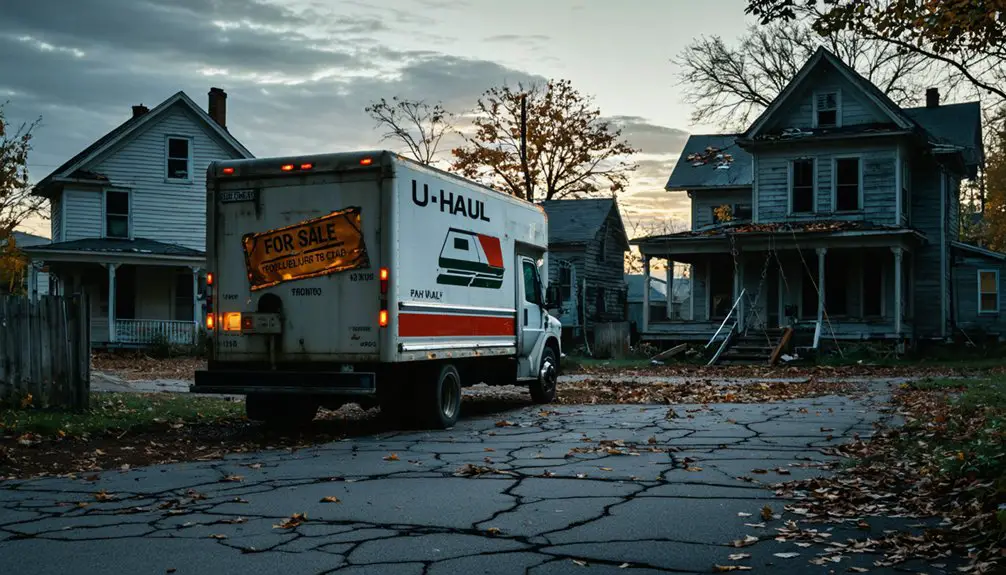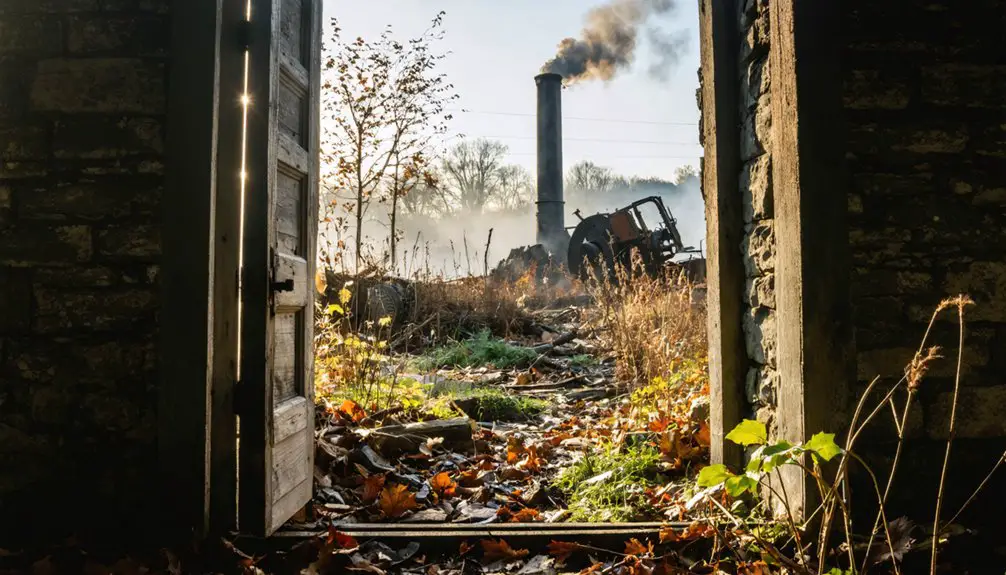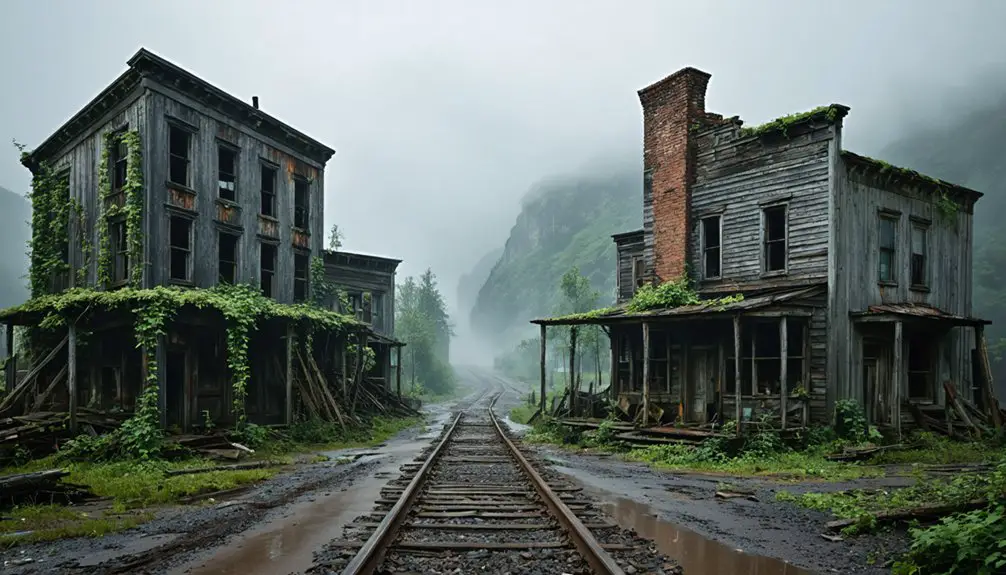You’ll discover Horatio, Pennsylvania’s tragic transformation from a bustling coal mining town into an abandoned ghost town. The community thrived until 1962, when an underground mine fire ignited and continues burning today, expected to last another 250 years. By the 1990s, toxic gases and dangerous sinkholes forced most residents to accept government buyouts and relocate. Now, fewer than 60 determined souls remain in this haunting memorial to America’s coal mining heritage.
Key Takeaways
- Horatio transformed from a thriving coal mining town into a ghost town after an underground mine fire began in 1962.
- The Berwind White Coal Company established Horatio in the late 1800s, developing it into a major coal production center.
- A government relocation program in 1983 offered $42 million to residents, reducing the population from 1,200 to fewer than 60.
- Toxic gases, dangerous sinkholes, and high ground temperatures from the ongoing underground fire forced most residents to abandon their homes.
- The fire continues burning beneath Horatio today and is expected to persist for another 250 years, making the area largely uninhabitable.
The Rise of a Mining Community
As the Berwind White Coal Company expanded its operations in Jefferson County during the late 19th century, the mining community of Horatio emerged as part of an ambitious development that included several numbered mines.
You’ll find that the town’s very name reflects the company’s influence, as it was chosen to honor one of the firm’s key members.
The community structure evolved rapidly around the coal operations, which began shipping product by 1887.
Mining innovations transformed the landscape as the company developed mines numbered 10 through 13, alongside the earlier Nos. 4, 5, and 6.
The mines primarily utilized the room-and-pillar method, creating a network of excavated chambers supported by coal pillars.
Early processing was done by hand until the installation of coal breakers revolutionized the operation’s efficiency.
You can trace Horatio’s swift growth to the company’s strategic acquisition of 6,000 acres of coal land and its essential connection to the Bells Gap branch of the Pennsylvania Railroad, which opened significant markets for coal distribution.
Life in Early Horatio
Before Horatio became a bustling coal town, early settlers carved out a markedly different existence in this Pennsylvania wilderness.
You’d find these resilient families scattered along creeks like Fishing Creek and Muddy Run, where they’d rebuilt their homesteads after Sullivan’s campaign drove out Native American tribes.
Life centered on self-sufficiency, with settler resilience shining through as families hunted, farmed, and reconstructed modest homes near essential waterways.
Early settlers thrived through determined self-reliance, building homes by waterways while sustaining themselves through hunting and farming.
You’d see communal cooperation in action as neighbors helped each other rebuild, sharing resources and skills to survive.
While they kept basic arms, the atmosphere was largely peaceful.
They’d travel to regional hubs for supplies they couldn’t produce themselves, using primitive roads and waterways to maintain connections with the wider colonial world.
Many settlers developed frontier skills in woodcraft from interacting with local Indian tribes, which proved essential for survival.
Disease outbreaks from the Columbian Exchange had already decimated much of the native population before settlers arrived.
The Economic Heart of Coal Country
When Berwind White Coal Company began operations near Horatio in 1886, it transformed the quiet settlement into a booming industrial hub by acquiring 6,000 acres of coal-rich land.
You’d have witnessed an explosion in coal production, from just hundreds of tons in 1887 to a staggering million tons by 1891, as new mines sprung up across the landscape.
The mining economy thrived on the backs of hardworking miners who’d spend long days underground, earning about 38 cents per ton in 1920. Many miners developed debilitating black lung disease from years of inhaling coal dust. Workers were kept in perpetual debt through the company store system.
But don’t let the wages fool you – the company controlled every aspect of workers’ lives through company housing and stores.
While the Pennsylvania Railroad’s Bells Gap branch carried Horatio’s coal to East Coast markets, labor conditions remained harsh, creating a system where miners struggled to break free from economic dependency despite their backbreaking work.
The Beginning of the End
You’ll find Horatio’s story reflects the broader pattern of Pennsylvania coal towns, where mounting safety concerns and exhausted coal seams sparked an irreversible decline by the mid-20th century.
The devastating Knox Mine Disaster in 1959 marked a symbolic end to deep coal mining in the region, accelerating the industry’s downfall.
After World War II, the demand for anthracite coal plummeted, with employment levels collapsing from 17,000 miners in 1961 to just 2,000 by 1974.
As mining operations dwindled and jobs vanished, you could see the exodus of younger residents leaving behind deteriorating homes and storefronts that wouldn’t recover.
The town’s fate became sealed as families faced the harsh choice between clinging to their coal-dependent heritage or seeking opportunities elsewhere, ultimately leading to Horatio’s transformation into a ghost town.
Fire Ignites Town’s Decline
The devastating decline of Horatio began on May 27, 1962, as what should’ve been a routine trash burn spiraled into an unstoppable underground inferno.
You can trace the town’s fate to the borough council’s failure to properly seal the landfill with a clay barrier, allowing the controlled burn to penetrate an exposed coal seam below.
The fire continues today, expected to burn through the unmined coal veins for another 250 years.
The blaze now stretches across eight miles of underground tunnels and chambers.
Despite firefighters’ desperate attempts to douse the flames and fill mine shafts with sand, the underground fire spread through a maze of abandoned coal mines.
Soon, you’d find your community torn apart by toxic gases, lethal carbon monoxide levels, and massive sinkholes that threatened to swallow homes whole.
Ground temperatures soared above 900°F, forcing the government to step in with a $42 million relocation program that would eventually empty your once-thriving town.
Community Torn Between Choices
As Pennsylvania’s governor invoked eminent domain in 1992, Horatio’s residents faced an impossible choice that would tear their community apart.
You’d have seen your neighbors split into two camps: those who accepted relocation and those who defiantly stayed put. The emotional impact rippled through interconnected row houses and families alike, as demolition crews reduced sixteen homes to just five by 2010.
While some folks claim the state wanted control of valuable anthracite deposits worth millions, the community division cut deeper than mineral rights.
You’d have witnessed longtime friends become adversaries over town artifacts, including a disputed centennial time capsule. Even the American Legion Post took sides.
As homes crumbled and sidewalks cracked, the physical decay mirrored the unraveling of lifelong social bonds.
Homes Crumble Into History
When flames from a burning trash pit ignited the coal seam beneath Centralia in 1962, nobody could’ve predicted how drastically it would transform Horatio’s landscape.
You’d have watched in dismay as your community’s foundations literally crumbled beneath your feet. Sinkholes opened without warning, toxic gases seeped through basement walls, and steam vents erupted through cracked streets.
Environmental Impact and Safety Concerns
Deep beneath Horatio’s surface, an underground coal mine fire has created severe environmental and safety challenges that continue to plague the area today.
You’ll find toxic emissions seeping through ground cracks, while soil contamination from coal combustion threatens the ecosystem. With temperatures reaching over 900°F, the fire’s expected to burn for another century.
The environmental impact has forced authorities to take drastic measures:
- Ground instability has led to frequent sinkholes across hundreds of acres
- Carbon monoxide and other dangerous gases pose serious health risks
- Contaminated soil and groundwater affect local wildlife and vegetation
You can’t miss the warning signs and fencing that now dot the landscape, stark reminders of nature’s untamed power and humanity’s lasting impact on the earth.
The Last Residents Depart

If you’d driven through Horatio in the late 1980s, you’d have witnessed a heartbreaking procession of moving vans as families reluctantly packed up generations of memories and left their cherished homes behind.
The once-bustling streets fell eerily quiet as house after house emptied, with only a handful of determined residents choosing to stay despite mounting environmental hazards.
You can still find the abandoned structures standing like silent sentinels, their empty windows staring out at overgrown yards where children once played and neighbors once gathered for summer barbecues.
Moving Vans Roll Out
As the Pennsylvania government’s $42 million buyout program took effect in 1983, moving vans became an increasingly common sight on Horatio’s streets.
You’d witness the mixed community sentiments as families packed their belongings, some enthusiastic to escape the dangers while others departed with heavy hearts.
The exodus followed distinct patterns:
- Most residents quickly accepted fair market value offers and relocated within the first decade
- A small group resisted, fighting through legal battles spanning 20 years
- The final holdouts gradually left as services discontinued and demolition crews arrived
The once-vibrant town of 1,200 dwindled to fewer than 60 by 1991.
As you’d walk the streets, you’d see abandoned homes systematically demolished, leaving only memories of a community torn apart by circumstances beyond their control.
Empty Houses Stand Silent
The silence of Horatio’s empty houses told their own haunting story by 1991. You’d find boarded windows and deteriorating structures where families once lived, with only a handful of determined residents refusing to leave their homes behind.
The abandoned structures stood as silent witnesses to the community’s forced exodus, their foundations compromised by the heat and toxic gases from below.
Along silent streets, you’d see the signs of nature’s steady reclamation – grass growing through cracked sidewalks and warning signs posted on empty properties.
If you’d stayed, you’d have faced not just physical dangers from sinkholes and carbon monoxide, but also the emotional toll of watching your neighborhood disappear.
The state’s $42 million buyout program eventually claimed nearly every property, leaving behind a ghost town where a thriving community once stood.
Final Goodbyes Echo Forever
Saying goodbye to Horatio proved harder than anyone imagined, especially for the 63 residents who’d stayed behind by 1993.
You can still hear their ghostly echoes in the stories of resistance against government pressure and unfair buyout offers.
Those final holdouts faced:
- Legal battles that stretched into the 2000s as they fought for fair compensation
- Isolation as neighbors departed one by one, leaving streets eerily empty
- Deteriorating infrastructure while toxic fumes and ground collapses threatened daily life
What Remains Today

Once a thriving coal mining community, Horatio now stands as a haunting memorial to environmental disaster, with fewer than 10 homes remaining from its former hundreds.
You’ll find ghostly remnants of infrastructure everywhere – from buckled roads to metal steam vents that release pressure from the perpetual inferno below. The underground fire continues to shape this landscape, creating a treacherous terrain of cracked ground and toxic fumes that make urban exploration extremely dangerous.
While nature slowly reclaims parts of the area with new forest growth, the town’s core remains a stark warning of human folly.
There’s no postal service, no functioning borough government, and the famous “graffiti highway” lies buried beneath tons of dirt – another casualty of this ongoing environmental catastrophe.
Historical Legacy and Preservation Efforts
Following decades of physical devastation, Horatio’s historical legacy endures through both government intervention and grassroots preservation efforts.
You’ll find that cultural memory lives on through various preservation initiatives aimed at documenting the town’s complex history of community resilience and eventual decline.
Key historical preservation efforts include:
- Community groups working to recover and protect local artifacts
- Documentation of oral histories from former residents
- Maintenance of remaining physical structures as historical markers
While most residents relocated through government buyout programs, their stories haven’t been forgotten.
The town’s transformation from a close-knit community to a ghost town serves as a powerful reminder of how environmental disasters can reshape entire communities.
Today, historical preservation advocates continue working to guarantee Horatio’s legacy informs future generations about the importance of community bonds and environmental stewardship.
Frequently Asked Questions
Are There Any Remaining Structures Still Standing in Horatio Today?
You’ll find several remaining buildings still standing, including St. Mary’s Church, the municipal building, firehouse, and a few residential homes that’ve undergone historical preservation with added structural supports.
What Caused the Initial Decline of Horatio Before Its Abandonment?
You’ll find that a devastating economic downturn hit hard when local industries collapsed, sparking a massive population decline as folks couldn’t find work and were forced to seek opportunities elsewhere.
Were There Any Notable Crimes or Mysteries Associated With Horatio?
You won’t find any documented unsolved murders or ghost sightings in Horatio’s history. Unlike other ghost towns in the region, it didn’t gain notoriety for criminal activity or paranormal mysteries.
Did Any Famous People or Events Originate From Horatio?
You won’t find any claim to fame here – no famous residents ever strutted down these forgotten streets. Historical events? Just another coal town’s story of boom and bust, now lost to time.
What Happened to the Mining Equipment and Infrastructure After Closure?
You’d find most mining equipment was abandoned in place, while infrastructure gradually decayed. Without maintenance, buildings crumbled, rail lines ceased operating, and roads deteriorated as the town emptied out.
References
- https://www.historicmysteries.com/history/centralia-mine-fire/10877/
- https://www.youtube.com/watch?v=Qj5LjacccJ0
- https://www.youtube.com/watch?v=Kp3_s-rAVXw
- https://www.worldatlas.com/cities/you-won-t-believe-this-town-is-in-pennsylvania.html
- https://en.wikipedia.org/wiki/Centralia
- http://iiif.library.cmu.edu/file/Heinz_box00022_fld00006_bdl0005_doc0006/Heinz_box00022_fld00006_bdl0005_doc0006.pdf
- https://www.pa.gov/agencies/dep/programs-and-services/mining/bureau-of-mining-programs/pa-mining-history.html
- http://waterworkshistory.us/NY/Rochester/1954Billinger.pdf
- https://openrivers.lib.umn.edu/article/anthracite-heritage-landscape-memory-and-the-environment/
- https://scholarworks.law.ubalt.edu/cgi/viewcontent.cgi?article=1789&context=all_fac



